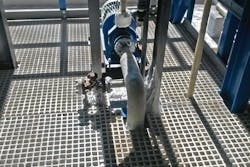Pumps are usually categorized in two major groups: conventional-sealed pumps and seal-less pumps. The first group contains pumps that need a seal system, usually in the form of a mechanical seal. The second group includes all types and models of seal-less pumps; these pumps do not require a seal. Magnetic-driven pumps are an important class of seal-less pumps. They are used for services in which leaks cannot be tolerated or liquids are difficult to seal. Magnetic drive pumps, also known as magnetically coupled pumps, vary from the traditional pumping style because the electric motor (the driver) is coupled to the pump by magnetic means rather than by a direct mechanical shaft. The pump works via a drive magnet that eliminates any shaft sealing required by the pump. This is a major advantage. On the other hand, magnetic drive pumps cannot be used in some applications and do have limits for power ratings. This article discusses magnetic drive pumps in processing facilities and their characteristics, advantages and disadvantages.
Magnetic drive pumps
Magnetic drive pumps are typically used where leakage of the pumped liquid poses a great risk such as with aggressive or risky liquids, exotic materials, acids, alkalis, corrosives, pollutants and toxics. They are also used for ultra-pure liquids and hard-to-seal liquids. Sealed pumps applied to these types of services may leak over time or require complex, expensive double seals to prevent hazardous/challenging liquids from escaping to the atmosphere, which can lead to safety hazards, downtime and increased maintenance requirements.
Another important application for magnetic drive pumps is for difficult liquids; for example, some liquids can crystallize on seal faces, which then can cause seal failures. To avoid this, a permanent flush system should be run to the seal. This, however, can increase the cost of maintenance, seal flushing liquids and energy consumption. A better solution for these difficult services is to use a magnetic drive pump.
Magnetic drive pumps have no direct connection between the electric motor shaft and the impeller; therefore, no seal is needed. There is no risk of leakage unless the pump casing is broken. Seals are known as a major cause of pump trips and unscheduled shutdowns. Obviously, the elimination of seals is a great improvement for performance, reliability and availability of pumps. The risk of leakage is completely eliminated; this means that liquids can be pumped without spillages. Eliminating the seals also gets rid of associated friction loss, wear, costs and noise. This provides complete separation of liquid from the pump drive and better transfer of motor power to the pump. There is practically no heat transfer from the electric motor because the pump chamber is completely separated from the electric motor by a large air gap; this provides an effective barrier between the two. The magnetic coupling will soften any shock or spike torques. Even in extreme situations, it will act as a fuse. Magnetic couplings can be broken temporarily if the load of the pump is too great. In practice, it means the pump does not overload and get damaged.
Magnetic drive pumps are available in most metallurgies and materials, metallic and nonmetallic. Polymer lining pumps are also used because they offer improved corrosion resistance. Polymer coating options include polytetrafluoroethylene (PTFE), perfluoroalkoxy alkanes (PFA) and polyvinylidene fluoride (PVDF). These lined or non-metallic options are usually employed for ordinary temperatures, below 90°C as a rough indication. Metallic magnetic drive pumps have been used for even higher temperatures.
Bearings for magnetic drive pumps
Because a magnetic drive pump is an enclosed piece of equipment, lubrication oil or grease cannot be used for bearings. Therefore, pumped liquid is used for the lubrication of bearings as well as for cooling needs. A portion of pumped liquid is usually taken from the discharge of the pump; this flow is often known as recirculation flow and is usually employed for the cooling of the magnetic system, lubrication of radial and thrust bearings and for other similar applications where lubricant or cooling fluid is needed.
Magnet drive pumps are usually equipped with "sleeve bearings," which use the pumped liquid for hydrodynamic lubrication. A sleeve bearing is one of the simplest types of bearing, comprising just bearing surfaces and no rolling elements. Therefore, the sleeve or journal slides over the bearing surface where pumped liquid is used for its lubrication. These bearings are also compact and lightweight and have a high load-carrying capacity and longer life compared to many rolling-element bearings. The materials of construction of these and the required clearances of the sliding surfaces may restrict the liquids and services for which this kind of pump may be used.
Traditionally, magnetic drive pump bearings have been made from silicon carbide, which has been an excellent bearing material under normal operation; however, it can suffer during some abnormal conditions such as dry running, dynamic loading and potential impact. Some modern materials such as advanced ceramics have been used in these with great success. Another proposed material is a fiber-reinforced silicon carbide ceramic composite with bearing properties similar to silicon carbide, but with high impact resistance and excellent tolerance of dry running. These modern options offer great benefits such as better impact resistance, excellent wear resistance and generally longer life and better performance.
Modern sleeve bearings for magnetic drive pump applications should feature smooth surfaces whether by a dedicated surface treatment on sleeve surfaces or a coating to sufficiently reduce the coefficient of friction, which enables longer periods of safe operation under dry run conditions. Dry running can occur from a wide range of malfunctions and maloperations. The heat generation from dry running conditions is the number one mode of failure for magnetic drive pumps. Modern bearing materials are usually up to two times harder than conventional silicon carbide, ensuring they won’t be compromised in even the harshest operational environment.
To successfully perform its task of lubrication and cooling, the recirculated flow should remain in the liquid phase at all points at all times. An area for concern is the magnetic coupling area where the intense heat could boil the liquid. Therefore, a robust design and sufficient flow rate are needed for these areas. The determining factors for preventing phase change are the mass flow rate, heat capacity and localized pressure at any point within the system. The details related to recirculation flow will affect the variables of mass flow rate and localized pressure.
To act as a lubricant, the pumped liquid should maintain a proper film thickness (at least a few microns) at operating temperature and load or else the sleeve bearings will experience severe wear. Many liquids such as hot water and most solvents do not have this property and cannot act as lubricant. On the other hand, if sufficient pressure or flow rate is not provided for the liquid through the bearings and other critical areas, it leads to overheating of the area, which can become a serious problem. The result can be flashing of the liquid and a potential loss of lubricating ability as the liquid increases in temperature and decreases in viscosity.
Disadvantages and limitations
Because magnetic drive pumps utilize magnets to transfer the torque and power from the drive assembly to the impeller assembly, there are some limitations with these pumps. For example, when magnet materials are exposed to temperatures above their threshold, they can begin to lose their magnetism. Therefore, temperature characteristics of each service are a critical factor. Some energy is lost in the magnetic coupling. This is primarily due to some magnetic resistance. As the result of this and some other effects, a typical magnetic drive pump is usually less efficient than conventional centrifugal pumps.
There are some limitations in power rating as a very large or powerful magnetic coupling is neither feasible, nor cost-effective. Power and torque limitations should always be considered for the selection of these pumps.
One of major limitations of magnetic drive pumps is the risk associated with running dry. Because the pumped liquid will act as lubricant and coolant, in case of dry run, the bearing and some other parts could overheat and eventually become damaged. In services and applications with risks of dry running, magnetic drive pumps should not be used.
Magnets should be sized correctly so magnetic-coupling breakaway torque is not exceeded during startup or in all other potential transient operational cases. If breakaway torque is exceeded, the magnetic coupling between the drive and the driven assemblies is lost, and the impeller will cease to spin, which means the pump should be tripped to allow the magnets to recouple. These pumps are also extremely sensitive to transient cases such as low flows and operation near shutoff head conditions.
Magnetic drive pumps for liquids containing solids
Magnetic drive pumps have very limited solids handling capability. The pumped liquid should be clean or else the solids will collect in the passages surrounding the magnet and in the close tolerances of bearings such as between the sleeves. This will interfere with the pump’s performance and cause problems, sometimes even failures. In addition, solids will wear out the bearings and other components.
Liquids containing ferrous particles are problematic in a magnetic drive pump because the particles collect on the magnet and can cause the pump to weaken and even stop working over time. Theoretically, sleeve bearings might be able to grind up some particles of a lesser hardness; this has resulted in some claims for solids handling capabilities of magnetic drive pumps. These "wild" claims by some manufacturers have been extraordinary, exaggerated and even false. This solids handling capability depends on details, like the size of the solids as well as the materials and characteristics of the bearings — the presence of some solids can be less problematic with hard and strong bearing materials than with weaker materials used in some low-cost bearings.
As a rough indication, the upper percentage and size limits of solids in the pumped liquid might be noted as 1.5 percent and up to 70 microns. For some special pumps, the latter might be up to 100 microns. There was a case of very strong and robust magnetic drive pumps that successfully handled 2 percent or 2.5 percent of solids to 150 microns. The limit on particle size is usually dictated by bearing clearances. Higher particle size may be screened out with a screen, strainer or filter in the way of liquid to bearings. There can be pumps operated for 5 percent solids (or sometimes more) up to 200 microns (or even more) if a clean flush is provided to the magnetic drive or if a closed-loop system is fitted; such a system is a special one available only from a few manufacturers.
Indeed, the above-mentioned figures are some very simplified and rough limits. For a reliable and optimal selection of pump for each service, comprehensive analyses and studies should take into account characteristics and the nature of solids. For instance, sticky or fibrous solids may block bearings or flow channels. Highly abrasive solids will eventually wear parts, and in these services, strong wear-resistant materials should be selected for the maximum pump life. All potential operating ranges should be considered for a proper pump selection. At low flows, the recirculation will accelerate wear, and at higher flow rates, the high rates of solids will increase the wear rate.
Amin Almasi is a senior rotating machinery consultant in Australia. He is a chartered professional engineer of Engineers Australia and IMechE and holds bachelor’s and master’s degrees in mechanical engineering and RPEQ. He is an active member of Engineers Australia, IMechE, ASME and SPE and has authored more than 100 papers and articles dealing with rotating equipment, condition monitoring, offshore, subsea and reliability.



